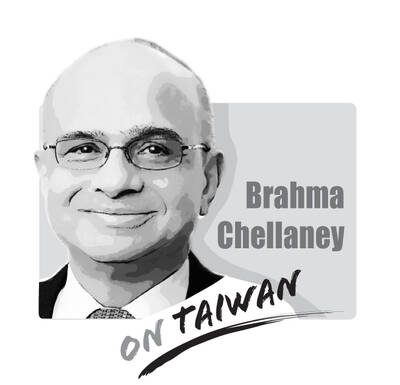To put the agreement between the Chinese Nationalist Party (KMT) and the Chinese authorities into perspective, just imagine that George McGovern, the Democratic challenger to US president Richard Nixon in 1972, had -- to boost his electoral chances -- flown off to Moscow and concluded a 10-point agreement with the Soviet Union. That the US would have been in uproar and McGovern accused of treason is a foregone conclusion. The real question, perhaps, is would he ever have dared return to the US, and how long would he have lived if he had?
Suffice it to say that not only did this never happen but it could not have happened since Americans, whatever their political stripe, have a rugged sense of their own national interest, even if they disagree among themselves as to how this should be pursued.
Can the same be said for Taiwan? Apparently not.
Amid all the outrage over Chiang Pin-kun's (
During Chen's first term there were very frequent trips to China by KMT apparatchiks and lawmakers. Chinese academics -- many of whom double as security personnel, by the way -- were quite frank about the message these visits were supposed to convey: Namely that Beijing should ignore Chen, thereby reducing him to a lame duck, and help the KMT back into power, after which serious negotiations could be opened. When Taiwan's public got wind of these dubious dealings, the reaction was to lose trust in the KMT, and this lack of trust cost the pan-blue ticket the election in March last year.
Were the KMT capable of introspection, it would realize this and understand that its way back into the good graces of the Taiwanese electorate should be to take a principled stand on the issue of Taiwan's status and China's threats. Instead, perhaps as a result of the DPP's inept legislative election campaign last autumn, which gave the false impression that KMT ideology still had value in Taiwan's electoral market, the KMT has continued to pursue narrowly defined party interests -- recovering power at any cost -- with the abetment of Beijing, to the detriment of broadly defined national ones: national sovereignty, dignity and self-determination.
Given the recent passage of Beijing's "Anti-Secession" Law, Chiang's trip was outrageous. Coming as it did on the heels of last Saturday's massive protests, it was a slap in the face for any Taiwanese of any political color who wants to maintain those liberties that China seeks to crush. But note that this is not anything new, it is simply a continuation of post-2000 KMT practice.
The question that has to be answered now is the degree to which the KMT's behavior is criminal. Any right-thinking person knows it to be contemptible. But is it illegal?
Certainly China's 10-point agreement seems to be in violation of the law, as Mainland Affairs Council Vice Chairman Chiu Tai-san (
And is the KMT itself a subversive organization in collusion with an enemy? It is about time that the highest security organs of the state launched a thorough investigation. The KMT has obviously gone too far; we need to know just how far that is.

Taiwan stands at the epicenter of a seismic shift that will determine the Indo-Pacific’s future security architecture. Whether deterrence prevails or collapses will reverberate far beyond the Taiwan Strait, fundamentally reshaping global power dynamics. The stakes could not be higher. Today, Taipei confronts an unprecedented convergence of threats from an increasingly muscular China that has intensified its multidimensional pressure campaign. Beijing’s strategy is comprehensive: military intimidation, diplomatic isolation, economic coercion, and sophisticated influence operations designed to fracture Taiwan’s democratic society from within. This challenge is magnified by Taiwan’s internal political divisions, which extend to fundamental questions about the island’s identity and future
The narrative surrounding Indian Prime Minister Narendra Modi’s attendance at last week’s Shanghai Cooperation Organization (SCO) summit — where he held hands with Russian President Vladimir Putin and chatted amiably with Chinese President Xi Jinping (習近平) — was widely framed as a signal of Modi distancing himself from the US and edging closer to regional autocrats. It was depicted as Modi reacting to the levying of high US tariffs, burying the hatchet over border disputes with China, and heralding less engagement with the Quadrilateral Security dialogue (Quad) composed of the US, India, Japan and Australia. With Modi in China for the
The Chinese Nationalist Party (KMT) has postponed its chairperson candidate registration for two weeks, and so far, nine people have announced their intention to run for chairperson, the most on record, with more expected to announce their campaign in the final days. On the evening of Aug. 23, shortly after seven KMT lawmakers survived recall votes, KMT Chairman Eric Chu (朱立倫) announced he would step down and urged Taichung Mayor Lu Shiow-yen (盧秀燕) to step in and lead the party back to power. Lu immediately ruled herself out the following day, leaving the subject in question. In the days that followed, several
The Jamestown Foundation last week published an article exposing Beijing’s oil rigs and other potential dual-use platforms in waters near Pratas Island (Dongsha Island, 東沙島). China’s activities there resembled what they did in the East China Sea, inside the exclusive economic zones of Japan and South Korea, as well as with other South China Sea claimants. However, the most surprising element of the report was that the authors’ government contacts and Jamestown’s own evinced little awareness of China’s activities. That Beijing’s testing of Taiwanese (and its allies) situational awareness seemingly went unnoticed strongly suggests the need for more intelligence. Taiwan’s naval